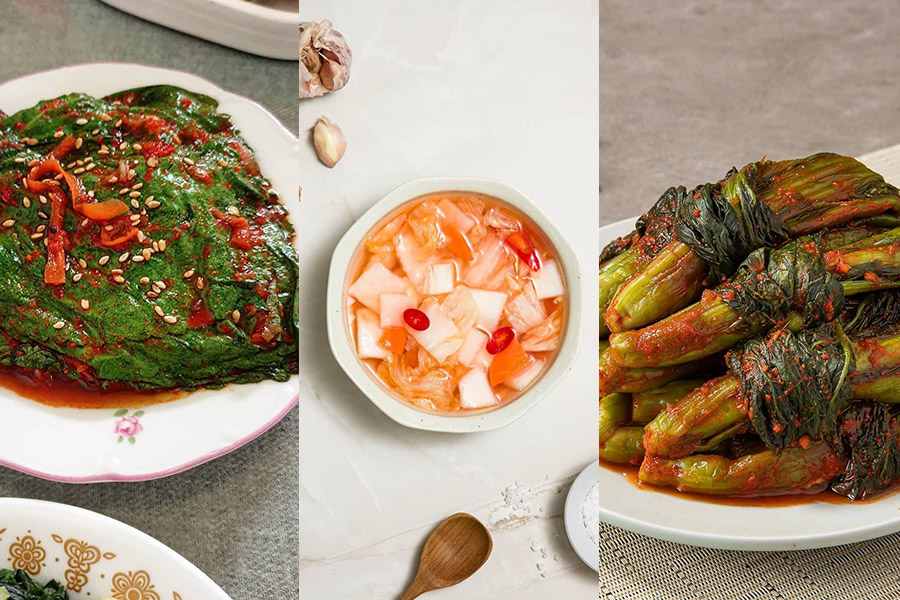When it comes to kimchi, most people immediately associate it with the usual bright red kimchi made using napa cabbages. However, the fermented dish can be made with other vegetables and can come even in non-spicy forms! Here are 10 different types of kimchi you should try:
10 Other Types of Kimchi Besides The Usual
Ponytail Radish Kimchi (총각김치)
The Ponytail Radish Kimchi, or Chonggak Kimchi in Korean, is a popular type of kimchi made using radishes known as Chonggak-mu.
Compared to your usual radishes, the ponytail radish is smaller in size and has long leafy stems. It is also crunchier and firmer compared to the usual radish.
Chonggak Kimchi is made using the whole radish with the leaves still intact. Pick up the whole radish and bite into it. Once you bite into a Chonggak Kimchi, it has a nice, satisfying and loud crunch sound.
This type of kimchi can be easily found in Korean marts in Singapore, or via a quick search online.
Gat-Kimchi (갓김치)
This particular kimchi is made using Gat, which are mustard leaves, coated in a mixture of red pepper, chili flakes, and more. Since the leaves themselves taste rather sharp and pungent, it tastes rather unique compared to the usual napa cabbage kimchi.
The Dolsan Gat Kimchi is a particularly famous variety of Gat Kimchi, even in Korea. They use leaves grown in Dolsan island, which has a unique taste compared to the usual Gat.
Jongga has this type of kimchi, available for purchase online.
Green Onion Kimchi (파김치)
Green Onion is a huge part of Korean cuisine, so it’s no surprise that the Koreans made kimchi out of Green Onions.
It is also one of the easiest kimchi to make, requiring only minimal ingredients. However, for convenience, you can get it easily in Korean marts or online as well.
Kkakdugi (깍두기)
Cubed Radish Kimchi is probably one of the most common types of kimchi next to the baechu kimchi. You can find this served as a banchan even in Korean restaurants in Singapore.
The texture of Kkakdugi makes it a fun side dish, alongside its spicy and sweet flavours.
Sesame Leaves Kimchi (깻잎김치)
Kkaennip, or sesame leaves, is something not commonly seen in Singapore. We like to refer to this as the Korean version of the mint leaf.
The leaves by themselves can be used as a wrap for Korean BBQ meats, put in kimbap or even made into kimchi.
White Kimchi (백김치)
Widely referred to as the non-spicy version of kimchi, Baek Kimchi is white because it’s made without any chilli flakes. It has a mild and clean taste, sometimes even refreshing. Baek Kimchi is usually served alongside bossam.
You can get Baek Kimchi online or at Korean marts.
Cucumber Kimchi (오이소박이)
Oi-sobagi, is a type of cucumber kimchi that’s stuffed with vegetables and kimchi paste. While it can be consumed all year round, most Koreans make this during the summer as cucumbers are in season.
It’s a refreshing banchan, especially on hot days, which is why you’ll predominantly see this side dish during summer in Korea. But fret not, you can get it easily in Singapore through these homemade online kimchi stores.
During Summer
Young Summer Radish Kimchi (열무김치)
Speaking of summer, we must not leave out Yeolmu Kimchi. It’s a type of kimchi made using a type of leafy radish, and extremely popular during summer.
Koreans like to add Yeolmu vegetables to rice and noodles, creating summer specials like Yeolmu Bibimbap or Yeolmu Guksu.
Nabak Kimchi (나박김치)
Nabak Kimchi is a type of Mul Kimchi, which is kimchi in drinkable broth. This kind of kimchi usually has a lot of water compared to the ones you usually find.
Commonly eaten during spring and summer, the kimchi is made using radish, cabbage and sometimes even fruits. Instead of keeping this for a long time, Nabak Kimchi is eaten quickly since it tastes bad once it overripens.
During Winter
Dongchimi (동치미)
Another type of Mul Kimchi is Dongchimi. However, unlike Nabak Kimchi, Dongchimi is mainly eaten during winter and mainly contains radishes. It’s derived from the word 동침(冬沈) with the word Dong meaning winter.
It is typically made in the fall when radishes are plumper. The broth from Dongchimi can be used for making guksu or naengmyeon since it has a clean and clear taste.
While Dongchimi cannot be easily found in Singapore, you can find prepackaged Dongchimi Naengmyeon available for purchase online.
Different Types Of Kimchi To Try
If you’re a fan of kimchi, make sure to try out these different types of kimchi. While some might not be readily available in Singapore, keep these in the back of your head the next time you’re in Korea!
*Follow MiddleClass.sg on Facebook, Instagram, and Telegram for more food, travel, and trending stories!
